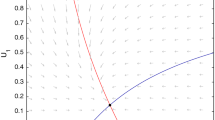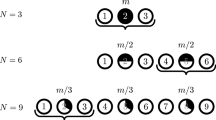Abstract
This paper considers the patch selection by a population without having full information about the utility of the patch, i.e., the amount of its energy resources. This problem is related to the optimal foraging theory. According to U. Dieckmann’s suggestion, the population distribution by patches should be modeled according to the utility function that takes into account the amount of resources per patch, the population–patch distance, and the extent to which the population is aware of the amount of resources in the patch. In this case, the population distribution by patches is described using the Boltzmann distribution. Dieckmann considers a static problem without taking into account the change in the position of the population over time. In this paper, we suggest a dynamic system that describes the population distribution by patches, which depends on the utility of patches that changes over time as a result of variations in the population–patch distance. That said, the Boltzmann distribution is a particular solution of the derived system of ordinary differential equations. The Lyapunov stability condition for the Boltzmann distribution is derived. The patch utility functions dependent on the distance to and the population’s awareness of the patch are introduced. As a result, in the 2D case the R2 space in divided in preferential utility domains. This partition generalizes G.F. Voronoy’s diagram.




Similar content being viewed by others
REFERENCES
Charnov, E.L., Optimal foraging, the marginal value theorem, Theor. Popul. Biol., 1976, vol. 9, pp. 129–136.
Patlak, C.S., Random walk with persistence and external bias, Bull. Math. Biophys., 1953, vol. 15, pp. 311–338.
Hoffmann, G., Optimization of Brownian search strategies, Biol. Cybern., 1983, vol. 49, pp. 21–31.
Bovet, P. and Benhamou, S., Spatial analysis of animals’ movements using a correlated random walk model, J. Theor. Biol., 1988, vol. 131, no. 4, pp. 419–433.
Fretwell, S.D. and Lucas, H.L., On territorial behavior and other factors inuencing habitat distribution in birds, Acta Biotheor., 1970, vol. 19, pp. 16–36.
Shuichi, M., Arlinghaus, R., and Dieckmann, U., Foraging on spatially distributed resources with sub-optimal movement, imperfect information, and travelling costs: Departures from the ideal free distribution, Synth. Ecol., 2010, vol. 119, no. 9, pp. 1469–1483.
Funding
This paper was supported by the Russian Foundation for Basic Research, project no. 18-01-00249а.
Author information
Authors and Affiliations
Corresponding authors
Ethics declarations
The authors declare that they have no conflicts of interest.
Additional information
Translated by S. Kuznetsov
About this article
Cite this article
Kirillov, A.N., Danilova, I.V. Dynamics of Population Distribution by Patches. Aut. Control Comp. Sci. 53, 738–744 (2019). https://doi.org/10.3103/S0146411619070095
Received:
Published:
Issue Date:
DOI: https://doi.org/10.3103/S0146411619070095




